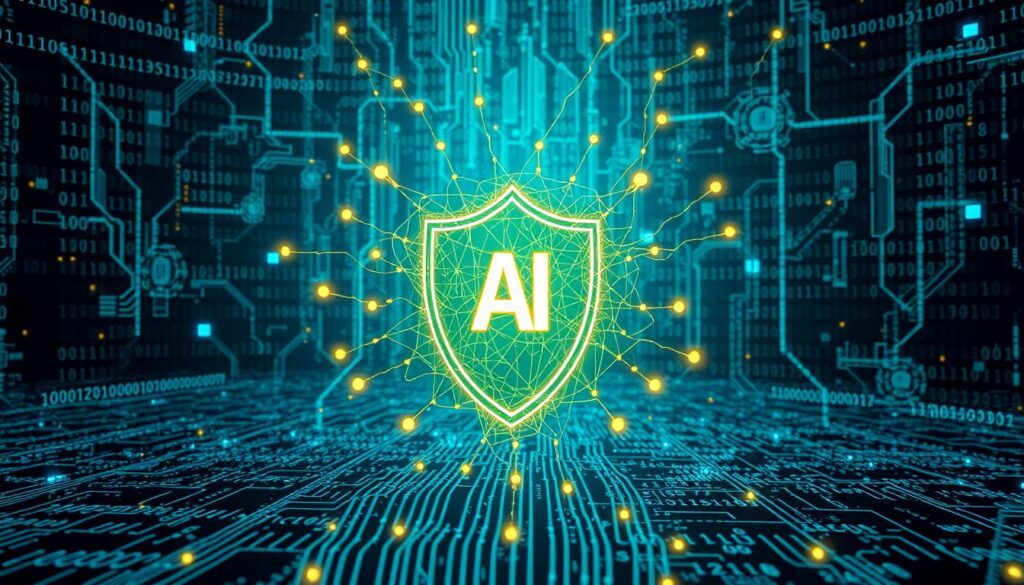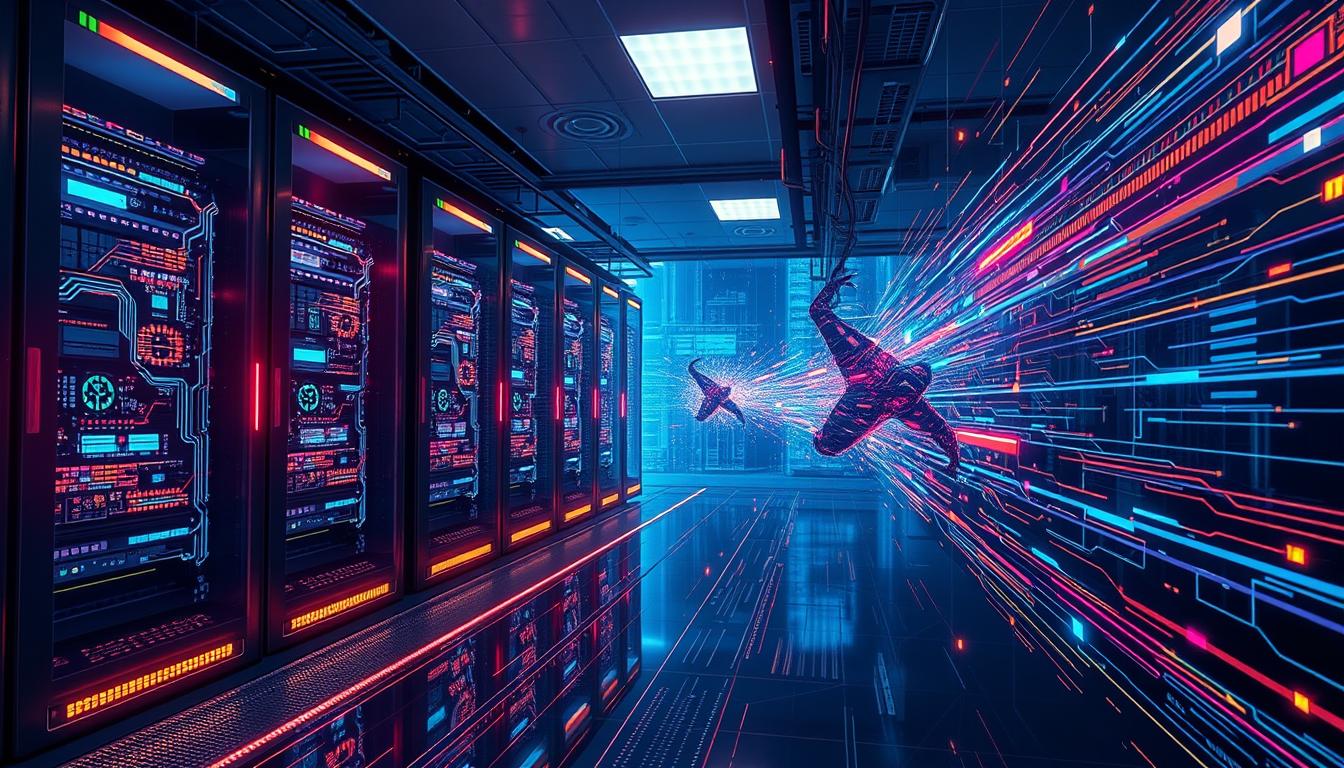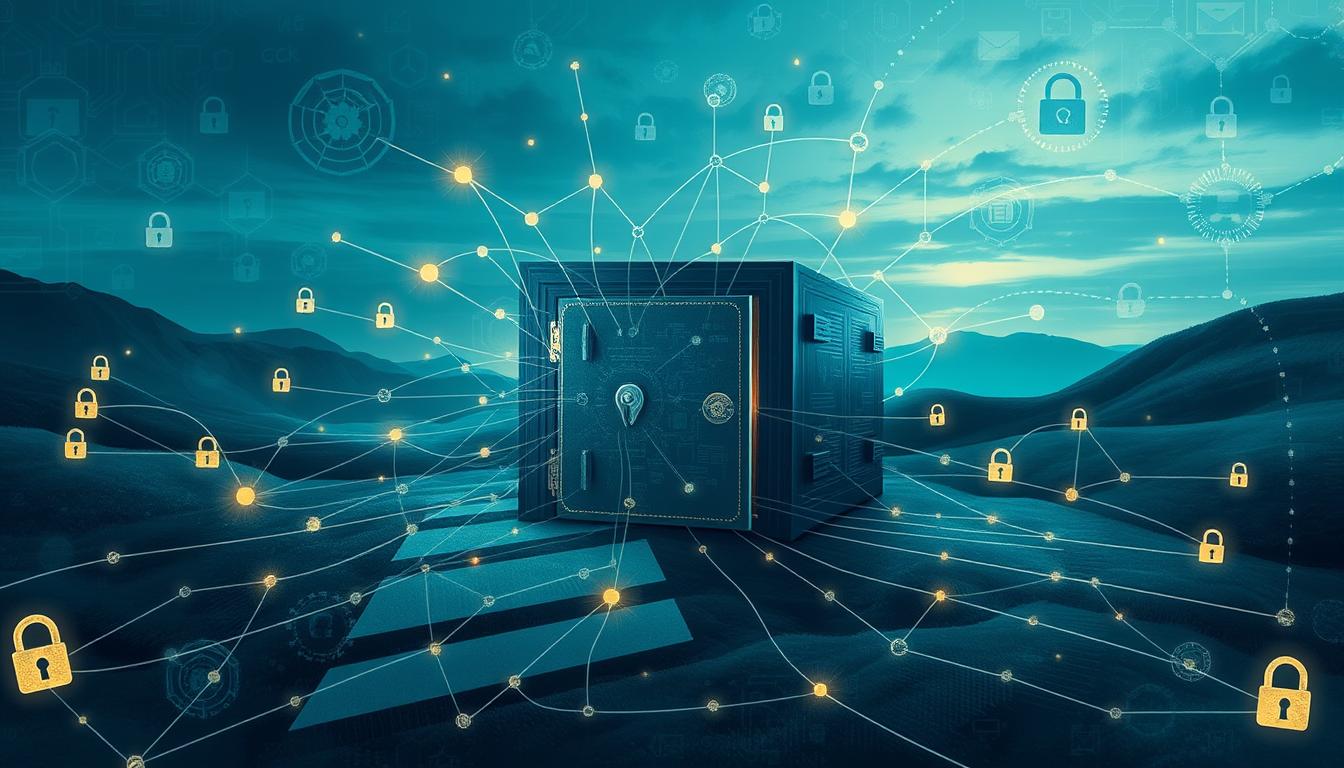Artificial Intelligence (AI) in cybersecurity is changing the game. It uses AI algorithms to analyze huge amounts of data. This helps spot patterns that show radicalization, aiming at vulnerable people for recruitment1.
AI is key because old security systems can’t keep up with new threats. These threats include automated attacks and AI that spreads extremist content fast on social media1. With AI, companies can boost their security and stay ahead of threats. This is making cybersecurity better and more efficient, with a market value expected to hit $46.3 billion by 20272.
AI’s role in cybersecurity is clear. About 60% of companies use AI in their security plans. And, attacks using AI and machine learning have jumped by 50% in 20212. As AI becomes more important, understanding its role in keeping us safe is critical. This includes knowing about new threats and how AI helps protect us.
Key Takeaways
- AI-powered algorithms analyze vast amounts of online data to identify patterns indicative of radicalization, targeting weak individuals for recruitment1.
- AI applications for improving cybersecurity efficiency are projected to be worth $46.3 billion by 20272.
- Approximately 60% of organizations reported that AI tools are part of their cybersecurity strategy2.
- Cybersecurity attacks employing AI and machine learning technologies have increased by 50% in 20212.
- Automated cyber attacks are expected to account for over 80% of all cybersecurity incidents by 20252.
- The global market for AI-based cybersecurity solutions is anticipated to reach $38.2 billion by 20262.
Understanding the Intersection of AI and Cybersecurity
AI has changed cybersecurity by letting systems analyze data, find patterns, and predict outcomes without being programmed3. This has brought new solutions beyond old rule-based systems. Machine learning, a big part of AI, helps in cyber defense by spotting threats and predicting attacks4.
AI security systems can quickly scan lots of data, finding odd patterns that might mean an attack is coming3. They can also find threats early, often before they cause big problems3. Also, predictive security analytics help businesses see and deal with cyber threats by looking at past patterns and trends3.
AI in cybersecurity has also led to more advanced cyber attacks, like AI-powered malware and phishing4. But AI can also help by scanning network traffic fast and getting better over time4. Plus, AI-driven solutions can look at huge amounts of data quickly, finding oddities that might mean an attack5.
In conclusion, AI and cybersecurity are changing fast, with both good and bad sides. As AI keeps changing how we fight cyber threats, it’s key to keep up with the latest in this field345.
AI and Cybersecurity: Battling Automated Attacks in Real-Time
Artificial intelligence is changing digital security. It helps companies get better at fighting cyber threats. AI can spot and understand threats faster than people can6. This is key because hackers are using AI to scan for weaknesses on a huge scale6.
AI can predict new threats and help find new problems. It also makes security teams work more efficiently6. The main benefits of AI in security are:
- It makes finding threats better by analyzing how people and systems act7
- It helps catch new threats before they are known7
- It keeps watching network traffic and logs for signs of trouble7
But, 70% of CISOs think AI helps hackers more than defenders8. AI can also make malware that changes itself to evade detection8. As AI in security grows, companies must keep up and use AI to stay safe.
Using AI and digital security helps companies fight cyber threats better. The need for AI in security is growing. It’s clear AI will be key in the future of keeping systems safe7.
Machine Learning Models for Threat Detection
Machine learning models are key in fighting cyber threats. They help companies keep up with automated attacks. By using machine learning, companies can sift through lots of data, spot patterns, and predict threats without needing to be told how9. This makes threat detection better and helps in being proactive about cybersecurity.
There are three main types of machine learning for threat detection: supervised learning, unsupervised anomaly detection, and reinforcement learning. Supervised learning can set off alerts for known threats like phishing emails or malware10. Unsupervised learning finds unusual data points, which helps in catching zero-day attacks or insider threats10.
Reinforcement learning makes cybersecurity systems better over time by learning from past actions10. Machine learning also gets better with time, leading to fewer false alarms for security teams10. Using AI and ML in cybersecurity can cut down the time to respond to threats by about 12 hours, reducing damage9.
Companies using AI for vulnerability management can lower the risk of attacks by focusing on the most critical vulnerabilities. This makes fixing problems 30% more efficient9. In fraud detection, AI and ML can quickly alert about suspicious transactions, catching anomalies with up to 95% accuracy9. By using machine learning, companies can improve their ability to detect threats and stay ahead of automated attacks.
For more info on how AI and machine learning are boosting cybersecurity, check out this link or this resource to see the future of cybersecurity and the role of AI and quantum computing.
Key Benefits of Machine Learning Models
- Improved threat detection capabilities
- Enhanced remediation efficiency
- Reduced risk of exploitation
- Real-time anomaly detection
- Optimized cybersecurity defense mechanisms
By using machine learning models, organizations can strengthen their cybersecurity. This helps them stay ahead of automated attacks, reducing cyber threats and protecting their assets11.
Implementing AI-Driven Security Solutions
AI in cybersecurity is a game-changer, overcoming traditional security limits12. It brings a proactive way to fight cyber threats, helping companies stay one step ahead. With 75% of security experts seeing more cyberattacks this year12, the need for strong security is clear.
AI systems cut down the time cyber attackers have to act, making security better13. They also make security work more efficient, saving money on labor costs13. The main advantages of AI in security are:
- Proactive threat detection and prevention
- Enhanced efficiency of security operations
- Reduced security operations costs
AI can also update software fast, a task that used to take humans a lot longer13. It boosts the ability to find and fight advanced threats13. As the demand for AI in cybersecurity grows, companies must invest in it to keep up with threats12.

| Benefits of AI-Driven Security Solutions | Description |
|---|---|
| Proactive Threat Detection | AI-driven systems can detect and prevent threats in real-time |
| Enhanced Efficiency | AI can automate security operations, reducing labor costs and improving response times |
| Reduced Security Costs | AI-driven security solutions can reduce security operations costs and minimize the risk of breaches |
Building Cyber Resilience Through Artificial Intelligence
Artificial intelligence is changing digital security in big ways. It offers predictive analysis and prevention, automated responses, and continuous learning. This helps companies stay ahead of cyber threats, lowering the risk of attacks.
Studies show AI makes threat detection faster, with some seeing an 80% drop in response times14. This means companies can act quicker to stop threats.
Combining AI with human skills can boost cybersecurity by up to 40%14. AI’s predictive analytics also cut successful attacks by up to 25% in using organizations14. AI makes digital security stronger, helping companies fight off new threats.
Experts say generative AI can spot threats early and accurately15. This move from reacting to acting ahead of threats cuts down on successful attacks. Generative AI also automates responses, speeding up threat resolution15.
To learn more about using generative AI for cybersecurity, check out this link. It covers the latest in AI security solutions.
Conclusion: Securing the Future with AI-Enhanced Cybersecurity
Organizations face a big threat from automated attacks. AI and cybersecurity are key to fighting this. Machine learning helps detect threats better and respond faster. Mid-sized companies get over 200,000 alerts daily, showing the need for AI in security16.
AI in cybersecurity helps prevent threats before they happen. This makes the future safer for companies. It’s a proactive way to keep data and systems safe.
The future of AI in cybersecurity looks bright. Trends like AI democratization and explainable AI are emerging. For more on AI and cybersecurity, check out ai in cybersecurity. Investing in AI security keeps companies safe from new threats.
AI’s ability to learn makes security better over time16. As threats change, AI helps keep up. It’s vital for companies to focus on AI-enhanced security and keep up with new tech.
FAQ
What is the role of AI in cybersecurity?
How does AI transform security protocols?
What are the key components of AI-powered security systems?
How can AI algorithms identify and assess threats in real-time?
What are the benefits of implementing AI-driven security solutions?
How can AI enable companies to build cyber resilience?
What is the future of AI in cybersecurity?
Source Links
- AI and violent extremism – Trends in 2025 – https://dig.watch/topics/violent-extremism
- Artificial intelligence | Digital Watch Observatory – https://dig.watch/technologies/artificial-intelligence
- Exploring the Intersection of AI and Cybersecurity: Is AI a Double-Edged Sword? – https://medium.com/kinomoto-mag/exploring-the-intersection-of-ai-and-cybersecurity-is-ai-a-double-edged-sword-85d62997a893
- Cybersecurity and AI: Navigating the Digital Frontier – https://www.lachmanconsultants.com/2024/11/cybersecurity-and-ai-navigating-the-digital-frontier/
- The Intersection of AI and Cybersecurity – https://www.linkedin.com/pulse/intersection-ai-cybersecurity-dr-amit-andre-ei3nf
- Cybersecurity in 2025: How AI is Redefining the Battle Against Cyber Threats – https://www.linkedin.com/pulse/cybersecurity-2025-how-ai-redefining-battle-against-cyber-vvkuc
- AI for Cybersecurity and Cybercrime: How Artificial Intelligence Is Battling Itself – https://www.computer.org/publications/tech-news/trends/ai-fighting-ai/
- Cybersecurity: AI vs. AI: The Battle for Cybersecurity – https://www.lanereport.com/173962/2024/05/cybersecurity-ai-vs-ai-the-battle-for-cybersecurity/
- AI and Machine Learning in the Battle Against Cyber Threats – https://www.onyxgs.com/blog/ai-and-machine-learning-battle-against-cyber-threats
- The Role of Machine Learning in Cybersecurity – https://swimlane.com/blog/the-role-of-machine-learning-in-cybersecurity/
- AI in Cybersecurity: Key Benefits, Defense Strategies, & Future Trends – https://www.fortinet.com/resources/cyberglossary/artificial-intelligence-in-cybersecurity
- The Need For AI-Powered Cybersecurity to Tackle AI-Driven Cyberattacks – https://www.isaca.org/resources/news-and-trends/isaca-now-blog/2024/the-need-for-ai-powered-cybersecurity-to-tackle-ai-driven-cyberattacks
- What Is the Role of AI in Security Automation? – https://www.paloaltonetworks.com/cyberpedia/role-of-artificial-intelligence-ai-in-security-automation
- AI’s Role in Shaping the Future of Cyber Defense – https://www.linkedin.com/pulse/ais-role-shaping-future-cyber-defense-decentcybersecurity-mfhtc
- Navigating the Future of Cybersecurity using Generative AI to Enhance Cyber Defense | JD Supra – https://www.jdsupra.com/legalnews/navigating-the-future-of-cybersecurity-5720071/
- AI in Cybersecurity – Uses, Threats & Prevention | 2024 | Engati – https://www.engati.com/blog/ai-in-cybersecurity










